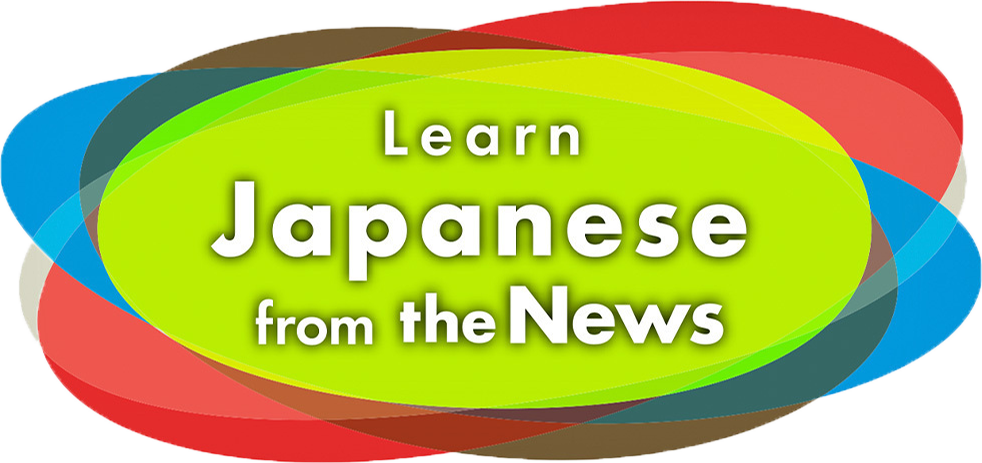
Learn Japanese from the News
Use the news to learn Japanese and take conversations to a new level.
沖縄は第二次世界大戦後、アメリカが統治していましたが1972年に日本に返還されました。今回は、そのときのことを記した資料が展示されている、というニュースです。このニュースを通して、沖縄についての理解を深めましょう。
おきなわは だいにじ せかいたいせんご、あめりかが とうちして いましたが 1972ねんに にっぽんに へんかん されました。こんかいは、そのときの ことを しるした しりょうが てんじされている、という にゅーすです。この にゅーすを とおして、おきなわに ついての りかいを ふかめましょう。
Okinawa wa dai-ni-ji-sekai-taisen go, amerika ga toochi-shite imashita ga, sen-kyuuhyaku-nanajuu-ni-nen ni nippon ni henkan-saremashita. Konkai wa, sono toki no koto o shirushita shiryoo ga tenji-sarete iru, to iu nyuusu desu. Kono nyuusu o tooshite, Okinawa ni tsuite no rikai o fukamemashoo.
After World War II, Okinawa was under U.S. rule until its return to Japan in 1972. Today’s news story is about the exhibition of documents from that time. Follow along to deepen your understanding of Okinawa.
1972年に沖縄がアメリカから日本に戻って、5月で50年です。
Play

English
May marks 50 years since Okinawa’s reversion to Japan from the United States in 1972.
Explanation
In this news story, 「沖縄」 refers to 「沖縄県(Okinawaken)」, that is, Okinawa Prefecture. When mentioning place names in everyday speech, it’s common to leave off suffixes such as 「県(ken)」 which means “prefecture” or 「市(shi)」 which means “city.” After World War II, U.S.-led forces occupied Japan for seven years. Okinawa, however, remained under U.S. rule for 27 years, until Prime Minister Sato Eisaku negotiated its return to Japanese sovereignty.
![]()
東京都にある国立公文書館で、沖縄に関係した書類40点ぐらいが展示されています。
Play

English
About 40 documents related to Okinawa are on display at the National Archives of Japan in Tokyo.
Explanation
「公文書」 refers to official government documents. In Japanese, we use counter words when counting things. Those words are based on the shape or other characteristics of what we’re counting. For example, for thin, flat objects such as paper, we use 「枚(mai)」. For books and diaries and other bound objects, we use 「冊(satsu)」. The news story mentions that the National Archives are displaying 「40点ぐらい(yonju-tten gurai)」, or about 40 items. The counter 「点(ten)」 is used when talking about the items or works of art on display in an exhibition or at a museum.
![]()
この中には、沖縄が日本に戻ることについて1971年6月に日本とアメリカがサインした書類があります。
Play

English
Among them is a document signed by Japan and the U.S. in June 1971 regarding Okinawa’s return to Japan.
![]()
佐藤栄作元総理大臣の日記もあります。1969年11月の日記では、アメリカに沖縄について話をしに行く前の日に、反対の運動をしていた学生などが捕まったことが書いてあります。
Play

English
There is also the diary of former Prime Minister Sato Eisaku. In a diary entry from November 1969, he writes about how on the day before he was to go to the U.S. to discuss Okinawa, students and others protesting the visit were arrested.
Explanation
The prime minister who negotiated with the U.S. for the reversion of Okinawa is Sato Eisaku. When we want to say that a person once held a certain position or job title, we use the prefix 「元(moto)」, which means “ex-” or “former.” So 「元総理大臣(moto sooridaijin )」 means “former prime minister.” 「元」 can also be used to describe our relationship or association with another person. If you’re out with a friend and happen to run into your former boss, you can introduce them as your 「元上司(moto jooshi)」.
![]()
国立公文書館は「書類などを見て、沖縄の歴史や人々の気持ちなどを考えてみてほしいです」と話しています。
Play

English
The National Archives of Japan says, “We hope that people will look at the documents and think about the history of Okinawa and the feelings of its people.”
![]()
Okinawa/Okinawa Prefecture
沖縄
おきなわ
Okinawa
official document
公文書
こうぶんしょ
koobunsho
former Prime Minister
元総理大臣
もとそうりだいじん
moto sooridaijin
![]()
Shuffle
日
Japanese
E
English


ロン(Long)
最近日本の会社で働き始めた。ソフィアの後輩。
アン、一恵と同じマンションの住人。

ソフィア(Sophia)
ロンと同じ会社で働く先輩。子育てをしながら、日本で5年間働いている。

田中健司
ロンの上司。中学生と、小学生の2人の子どもがいる。

アン(An)
夫が日本で働くことになり、一緒に日本で暮らしている。小学生の娘がいる。

鈴木一恵
ロン、アンと同じマンションの住人。現在は一人暮らし。
教材作成/国際交流基金日本語国際センター
The conversation today is between Long and a person who took a trip to Okinawa. Long saw Suzuki at the entrance of their apartment after coming home from shopping on his day off. She was carrying a reusable shopping bag with a unique pattern so Long asked her about it. Follow along to learn how to acquire detailed information about interesting travel spots. Some key terms in this dialogue include 「めずらしい」(unique/unusual), 「焼き物」(pottery), 「素朴」(rustic), 「通り」(street), 「伝統的な」(traditional), 「作品」(piece), 「デザイン」(design), 「作家」(artist) and 「きっと」(I’m sure ...).

ロン:そのエコバッグ、めずらしい柄ですね。
Play
Show

English
Your reusable bag has a unique pattern.
![]()

鈴木:ああ、これ?先週、沖縄旅行で買ったの。
Play
Show

English
Oh, this? I bought it during trip to Okinawa last week.
![]()

ロン:沖縄ですか。前に、友だちから沖縄の焼き物をもらったことがあります。えっと…、やむ、やち…。
Play
Show

English
You went to Okinawa? My friend gave me a pottery from Okinawa before. Umm... it was Yamu... Yachi…
![]()

鈴木:ああ、「やちむん」。沖縄の焼き物のことね。素朴で、いいよね。
Play
Show

English
Oh, you mean “Yachimun.” It's Okinawan pottery. I like its rustic quality.
![]()

ロン:はい。沖縄にはやちむんの通りがあるんですよね。
Play
Show

English
Yes. There is a street in Okinawa where lots of Yachimun are sold, right?
![]()

鈴木:そうそう。「やちむん通り」ね。ロンさん、焼き物に興味があるの?
Play
Show

English
Uh-huh. It’s called Yachimun Street. Long, are you interested in pottery?
![]()

ロン:少し。でも、伝統的なものより、若い人が作った作品が好きです。デザインがおもしろいです。
Play
Show

English
A little bit. But I like pieces made by younger generations more than the traditional ones. The designs are interesting.
![]()

ロン:「やちむん通り」には、そういうのも売っていますか?
Play
Show

English
Do stores in Yachimun Street sell pieces like that?
Explanation
In daily conversations, abbreviations and demonstrative pronouns are used to avoid repetitions. 「そういう」 means 「そのような」, and in this sentence it refers to 「若い人が作った」. Demonstrative pronouns that begins with 「そ」 are often used to indicate something that was just spoken. A noun comes immediately after the demonstrative 「そういう」. In this sentence, the word 「の」 is used in place of the noun 「作品」, therefore 「そういうの」 implies 「そういう作品」.
![]()

鈴木:うん。若い作家さんのお店もあるから、きっとロンさんが好きな作品を見つけることができると思うよ。
Play
Show

English
Yes. There are shops run by young artists, so I’m sure you will find something you like.
![]()

ロン:へえ。行ってみたいなあ。
Play
Show

English
Really? I want to go there someday.
![]()
![]()
![]()
Play All
![]()
Show All
![]()
Reset